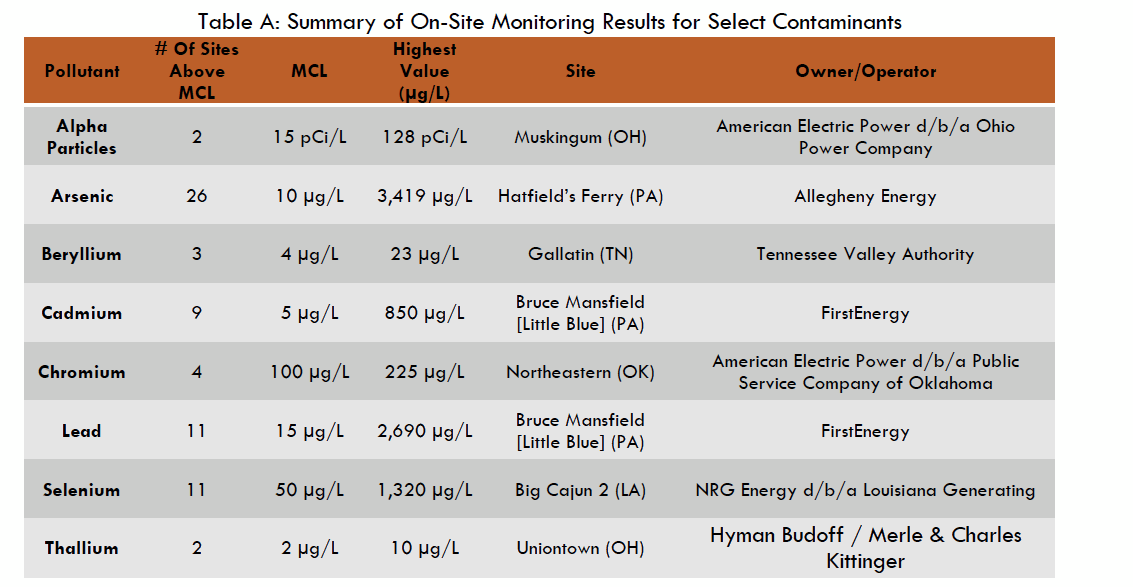ENVIRONMENTAL INTEGRITY PROJECT
EXECUTIVE SUMMARY
An investigation led by expert hydrogeologists has identified 39 more coal combustion waste (CCW) disposal sites in 21 states that have contaminated groundwater or surface water with toxic metals and other pollutants. Their analysis is based on monitoring data and other information available in state agency files and builds on a report released in February of 2010, which documented similar damage at 31 coal combustion waste dumpsites in 14 states. When added to the 67 damage cases that the U.S. Environmental Protection Agency (USEPA) has already acknowledged, the total number of sites polluted by coal ash or scrubber sludge comes to at least 137 in 34 states. This total represents nearly a three-fold increase in the number of damage cases identified in EPA’s 2000 Regulatory Determination on the Wastes from the Combustion of Fossil Fuels.
Drinking Water Standards Routinely Exceeded On-site, Sometimes by Orders of Magnitude
At every one of the 35 sites with groundwater monitoring wells, on-site test results show that concentrations of heavy metals like arsenic or lead exceed federal health-based standards for drinking water. For example, arsenic levels were above the 10 microgram per liter “maximum contaminant level” (MCL) at 26 of 35 sites, with concentrations reaching as high as 3,419 micrograms (over 341 times the standard) at the Hatfield’s Ferry site in Pennsylvania. Table A presents a summary of results for select contaminants.
Drinking Water at Risk
Where off-site sampling of private wells occurred, contaminated drinking water was found in every case.
States do not generally require off-site monitoring of drinking water wells beyond the fenceline, even when there is documented contamination at the property boundary. Nevertheless, at four of the five sites examined in this report for which such monitoring data are available, test results show violations of the federal MCL or a federal or state health advisory at one or more wells used for drinking water. At the fifth site (Joliet 9 (IL)), although off-site monitoring data are limited and consequently violation of federal or state standards are not confirmed, at least 18 nearby drinking water wells were closed due to boron contamination.
State records indicate the potential for more private wells to be contaminated.
Contaminated groundwater underneath at least 15 of the 39 sites is within two miles of private wells, according to monitoring data and public information on private well locations at the following CCW dumpsites: Independence (AR), Joliet 9 (IL), Lansing (MI), Cayuga (NY), Cardinal (OH), Gavin (OH), Muskingum (OH), Uniontown (OH), Northeastern (OK), Boardman (OR), Bruce Mansfield (PA), Hatfield’s Ferry (PA), Big Stone (SD), Fayette Power Project (TX), and Oak Creek (WI). Public information on private drinking water wells is often incomplete or out of date, but for at least eight of these CCW disposal sites – Joliet 9, Gavin, Lansing, Muskingum, Uniontown, Bruce Mansfield, Fayette Power Project and Oak Creek – there are 25 or more private drinking water wells at or within two miles of the site. At Joliet 9 and Uniontown, there are 90 or more private drinking water wells within a mile of the contaminated CCW disposal sites.
CCW contaminants may threaten public water wells or intakes, potentially requiring expensive cleanup.
Public wells that serve local communities have tremendous pumping capacities that often change the direction of groundwater flow and pull contaminated water into the public’s water supply. These pollutants must be removed at drinking water treatment plants, sometimes at great expense, to meet federal and state standards for safe drinking water. At least 18 of the 39 contaminated sites are located within five miles of a public groundwater well that could potentially be affected by CCW pollutants. In fact, there are at least five public water wells within a 5-mile radius of at least eight of those sites, namely: Flint Creek (AR); Montville (CT); Lansing (IA); George Neal North (IA); George Neal South (IA); Big Cajun (LA); Cardinal (OH); and Fayette Power Project (TX).
In several cases (e.g., Hatfield’s Ferry (PA), Gallatin (TN), and Johnsonville (TN)), CCW disposal sites are leaking their toxic cargo into rivers just upstream from intakes for public water systems. Often, metals like arsenic are discharged to rivers through adjacent groundwater. For example, monitoring wells in an aquifer that flows from the Hatfield’s Ferry (PA) site to the Monongahela River, less than half a mile away, have consistently measured arsenic at levels substantially above the MCL for the last five years. The contaminated groundwater discharges to the river are across from the water supply intake for the community of Masontown. Although historically, Pennsylvania has only required this public water system to test for arsenic every eight years, even in this limited testing, arsenic 2-3 times higher than the federal drinking water standard was found in the intake water at least twice since 2000. Groundwater discharges from CCW dumps may load drinking water sources with additional contaminants that must ultimately be removed from the water supply at public expense.
…
Download full report: IN HARM’S WAY
About Environmental Integrity Project
www.environmentalintegrity.org
“EIP combines research, reporting, and media outreach to spotlight illegal pollution, expose political intimidation of enforcement staff, and encourage federal and state agencies to take enforcement action to stop these practices. EIP’s work has been cited in Congressional hearings and debates, in reports by the US General Accountability Office, and in frequent news articles.”
Tags: CCW, Coal and Combustion Waste, Earthjustice, Environmental Integrity Project, Sierra Club







 RSS Feed
RSS Feed